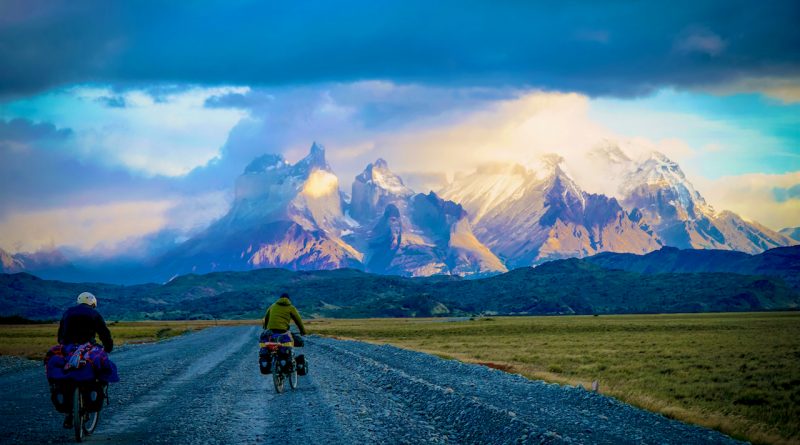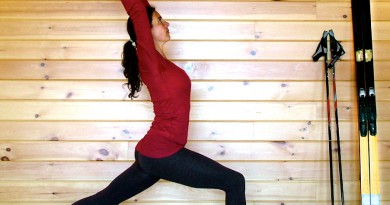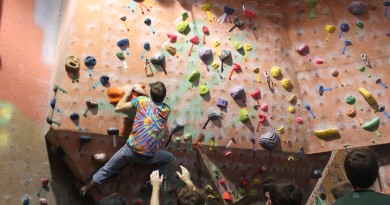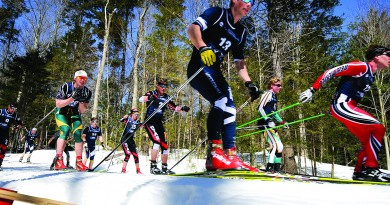It’s A Mundo Pequeño: A Ride From Patagonia To Vermont
Cameron Russell doesn’t just go for a ride, he goes for epic bike rides. Last fall, while working as the Coordinated Program Director for the Democratic Party in Vermont, he made a point of riding from every major town in Vermont to Montpelier. A few years ago, he rode across America. Now he’s on a quest to ride from Patagonia, the southernmost tip of South America, to Vermont.
Russell, Eli Bennett and Noah McCarter (both former students of Russell’s from the Darrow School in Massachusetts) set out from Ushuaia, Argentina in January, plotting a course that would take them up the Chilean coast into the mountains, lagoons, and salt flats of Bolivia, past Lake Titicaca and then up the Peruvian coast. “Noah’s got it in his head that he wants to surf Chicama, Peru, what’s billed as one of the longest waves in the world,” says Russell.
From there, they would head to Colombia. “There’s really no way to cross the Darién Gap to Panama,” Russell notes. So, in Colombia, Bennett and McCarter plan hop a small chartered sailboat and do a five-day passage to Panama. Russell, who planned a trip home then, will join them on the Caribbean coast of Panama and they’ll all continue north through Central America, Mexico and back through the southern U.S.
All in all, the trio expect to make the trip in 10 months.
“This trip is something I had been thinking about for a while,” says Russell, who was home in Burlington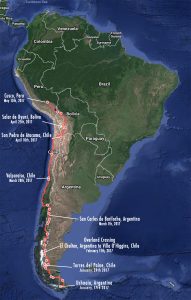 for a week in May, leaving his bike in Cusco, Peru. “When I was riding across America, I was by myself and was really struck by how generous and friendly people were. I remember being at one diner in Wyoming and talking with a trucker who was a few tables over. When I went to pay my bill, he’d already picked up the tab. ‘You don’t have to do that,’ I said to him. ‘I know, I’m not doing it out of pity, I’m doing it out of admiration,” he said. When you are on your bike, the world gets smaller. That’s what led to the idea of Mundo Pequeño.”
for a week in May, leaving his bike in Cusco, Peru. “When I was riding across America, I was by myself and was really struck by how generous and friendly people were. I remember being at one diner in Wyoming and talking with a trucker who was a few tables over. When I went to pay my bill, he’d already picked up the tab. ‘You don’t have to do that,’ I said to him. ‘I know, I’m not doing it out of pity, I’m doing it out of admiration,” he said. When you are on your bike, the world gets smaller. That’s what led to the idea of Mundo Pequeño.”
“Mundo pequeño,” Spanish for “small world,” is the name the trio gave to their expedition. They gave themselves a budget of $20 a day, packed their bikes with camping gear and set out to see just how small the world really is. Russell, who has studied in Nicaragua, is fluent in Spanish. “All along the way, we wanted to interview people to find out what mundo pequeño meant to them.” Armed with a small Bluetooth keyboard, one cell phone between the three, and camera gear, they maintain a regular blog about the journey at mundopequeno.org.
The trip started at Tierra del Fuego national park. The blog entry reads: “On our second day in the park, we climbed Cerro Guanaco. A mountain in the middle of the park. From above tree line and standing on the jagged peak we could see an incredible 360 view of the edge of the world. We had reached the end of the road. The last road. The part of the map that used to read “here there be dragons.” A place we had only dreamed of seeing, yet here we stood. A dream realized and manifested into cold hard stone under our feet and open clear sky above our heads. We climbed down the mountain feeling exalted and excited for the road ahead.
From there to the border of Chile, the riders battled headwinds that blew 60 miles an hour. “We were riding at the same speed as walking our bikes, the wind was so strong,” Russell says. “We soon figured out that if we got a really early morning start, it would be better.” A trucker, familiar with the plight of 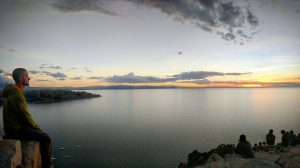 cyclists, picked them up at one point. “Faced with not having enough food and water, we obliged and accepted a ride in the semi trailer for about 30 km. We also realized at this point that we’d need to make decisions to hitchhike here and there if we wanted to stay on track,” says Russell, adding that strangers have usually been very generous with short rides when needed.
cyclists, picked them up at one point. “Faced with not having enough food and water, we obliged and accepted a ride in the semi trailer for about 30 km. We also realized at this point that we’d need to make decisions to hitchhike here and there if we wanted to stay on track,” says Russell, adding that strangers have usually been very generous with short rides when needed.
At night, they would stay in hostels, a gaucho’s bunk room, or wild camp by the road. Their route took them by ferry to Punta Arenas, Chile before crossing back over the border to Argentina and then back to Chile.
In Argentina’s Los Glaciares National Park, part of a larger ice field system which is the world’s third largest reserve of fresh water, they walked close enough to the glacier, Perito Moreno, to watch large pieces of ice fall a few hundred feet into the water below. “It took time to grasp the actual size of the glacier. It wasn’t until we saw a piece of ice the size of a small house free-fall for a few seconds and crash into the water, that we realized the scale,” says Russell.
The three took time to raft the Futaleufu River in Chile and visit the cabin where Butch Cassidy holed up in Argentina’s Lake District. In Lanco, Chile they stopped at an inn only to find it was out of their price range. “After being given permission to set up tents in the yard of the hotel for a reduced rate, the grandson of the innkeeper came to find us,” says Russell. “The innkeeper had decided to invite us to stay inside at a quarter of the price. When we asked her about why she had been so generous, she replied that she thought we would do the same and that she was always happy to help young people follow their dreams.”
“It’s that type of openness and hospitality that we’ve been met with most of the way,” says Russell. “We shared meals with gauchos and fellow travelers, took rides with truckers, twice, and pleaded with ferry captains to take our bikes. Nearly everywhere, we have been greeted with kindness.”
When you are on your bike, it is indeed a small world.
You can follow Mundo Pequeno at the blog mundopequeno.com and an excerpt from their blog follows.
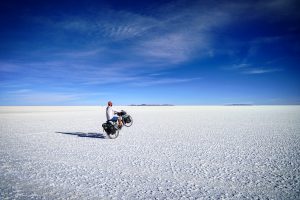
The most grueling and one of the most interesting portions of the Mundo Pequenño journey has been while traveling through the high mountains and salt flats of southwestern Bolivia. From the blog:
“As we prepared to leave San Pedro, Chile, we all checked and re-checked our supplies. We each had a days’ worth of food and two days of water. The crossing into Bolivia and the entrance to the lagoon route lay ahead and above us. We would then spend the next week crossing through the mountain passes before descending and getting to the next small town.
This route had been almost a mythical entity for us. We had heard again and again from cyclists heading south that the Lagoon Route was the hardest part of their trips. Some had said they pushed their bikes and couldn’t go more than a crawling pace. Others said that they had wept everyday. All three of us knew that this section would be a challenge, but none of us knew to what extent.
The largest challenge we knew to expect was the elevation. San Pedro de Atacama was at 8,000 feet and the highest point we would reach on the lagoon route would take us to 16,000 feet. The rst 30 miles or so of our ride would take us on a non-stop climb to 15,000 feet and to the border crossing into Bolivia. We had to break the climb into three days of riding to limit how much altitude we would gain in a day, allowing our bodies to adjust safely.
After crossing the border, we would have a full week in the windswept and desolate landscape of snow-capped volcanic mountain passes and shallow mineral-rich lagoons. It was an empty land with little life and inhospitable climate— stark in its lonely beauty with dry dusty plains of volcanic destruction spreading bellow. We would find ourselves in a world that looked like it came out of a science fiction novel and we all felt like wandering visitors. Our winding roads would be dirt and the winds fierce. This would be a test of how strong we had become.
The first night in Bolivia was spent aside Laguna Blanca, before we’d continue on Laguna Verde and to the thermal hot springs. After resting at the hot springs for a couple of days we continued over the highest point of the lagoon route at around 16,000 feet. The roads were worse than we’d seen yet, but we’d soon have a view of Laguna Colorada and a descent that led us to our next night’s sleep. Thankfully that would be indoors, as the temperatures often dipped to around 5 degrees Fahrenheit at night.
The next morning, we took our time riding the perimeter of Laguna Colorada, spending a little time with the pink amingos that frequent the lake. We reached the park border that day, and asked for help from the sta of a mining company at the border. Again, kindness and generosity greeted us as we were met with a hot meal and beds to sleep in. The following several days took us to Uyuni, Bolivia.
After the beautiful, but grueling lagoon route, we arrived in Uyuni tired and hungry for a meal other than bread, jam and spaghetti. We quickly found a nice hostel (that served eggs for breakfast) and took a couple days to rest and prepare for the next leg of our journey across the Salar de Uyuni—the world’s largest salt flats.
We rode north out of Uyuni before heading west, directly across the salt flats towards Isla Incahuasi, an island in the middle of the Salar. The first day took us about 30 kilometers from the island, where we decided to camp and enjoy the desert sunset. We’d also noticed that there were ‘potholes’ in the salar—literally holes in the salt surface. In each of the ‘potholes’ we thought we saw water, but later learned that there was a liquid brine beneath the salar made up of a number of different minerals. In this brine exists 50 to 70 percent of the world’s lithium reserves.
The next day, we pedaled on towards Incahuasi, unfortunately into a very strong headwind. After reaching the island, we enjoyed lunch inside before hitting the salar again–this time due north and with a slight side/tail wind. We also decided that this was our opportunity to try out bike sailing, yes bike sailing. We rigged up our tent ground cloths and set off, tacking north across the salar.
Though the salar was absolutely the experience of a lifetime, we all agreed that we were thankful to be back on a real (dirt) road and headed north towards La Paz the next morning.
The next few days took us back towards the main north/south route in Bolivia through rolling plains. Along the way, we’d stop in small working-class towns and bunked up in rustic alojamientos (or boarding houses) and bought food from local markets. Though we were and continue to be thankful for our travels, it was during these few days before arriving to La Paz that we found ourselves missing the comforts of home… a working shower, potable water, and family.”

